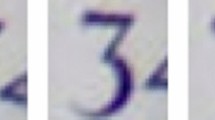Abstract
Convolutional neural networks (CNNs) are one of the deep learning architectures capable of learning complex set of nonlinear features useful for effectively representing the structure of input to the network. Existing CNN architectures are invariant to small distortions, translations, scaling but are sensitive to rotations. In this paper, unlike the approaches where training samples with different orientations are included, we propose a new architecture in which addition of a rotational invariant map gives few folds of improvement towards rotational invariance to the network. We also propose an improved architecture where rotational invariance is achieved by rotationally varying the convolutional maps. We show that the proposed methods give better invariance towards rotations as compared to conventional training of CNN architecture (where the network is trained without considering the different orientation of training samples). The methods achieve rotation-independent classification by introducing few modifications in conventional CNNs, but do not add any trainable parameter to the network, thus keeping the number of free parameters/weights constant. We demonstrate the performance of proposed rotation invariant architectures for handwritten digits and texture data sets.
















Similar content being viewed by others
References
LeCun Y, Bengio Y (1995) Convolutional networks for images, speech, and time series. In: Arbib MA (ed) The handbook of brain theory and neural networks. MIT Press, Boston, pp 255–258
Lauer F, Suen CY, Bloch G (2007) A trainable feature extractor for handwritten digit recognition. Pattern Recognit. 40(6):1816–1824
Simard PY, Steinkraus D, Platt JC (2003) Best practices for convolutional neural networks applied to visual document analysis. In: Null. IEEE, p 958
Ahranjany SS, Razzazi F, Ghassemian MH (2010) A very high accuracy handwritten character recognition system for Farsi/Arabic digits using convolutional neural networks. In: 2010 IEEE fifth international conference on bio-inspired computing: theories and applications (BIC-TA). IEEE, pp 1585–1592
Zagoruyko S, Komodakis N (2015) Learning to compare image patches via convolutional neural networks. In Proceedings of the IEEE conference on computer vision and pattern recognition, pp 4353–4361
Ijjina EP, Mohan CK (2014) Facial expression recognition using Kinect depth sensor and convolutional neural networks. In: 2014 13th international conference on machine learning and applications (ICMLA). IEEE, pp 392–396
Tivive FHC, Bouzerdoum A (2003) A new class of convolutional neural networks (SICoNNets) and their application of face detection. In: Proceedings of the international joint conference on neural networks, 2003, vol 3. IEEE, pp 2157–2162
Dong C, Loy CC, He K, Tang X (2015) Image super-resolution using deep convolutional networks. IEEE Trans Pattern Anal Mach Intell 38(2):295–307
Gopakumar G, Babu KH, Mishra D, Gorthi SS, Subrahmanyam GRS (2017) Cytopathological image analysis using deep-learning networks in microfluidic microscopy. JOSA A 34(1):111–121
Kandi H, Mishra D, Gorthi SRS (2017) Exploring the learning capabilities of convolutional neural networks for robust image watermarking. Comput Secur 65:247–268
Garcia C, Delakis M (2004) Convolutional face finder: a neural architecture for fast and robust face detection. IEEE Trans Pattern Anal Mach Intell 26(11):1408–1423
Lo S-CB, Chan H-P, Lin J-S, Li H, Freedman MT, Mun SK (1995) Artificial convolution neural network for medical image pattern recognition. Neural Netw 8(7):1201–1214
Tivive FHC, Bouzerdoum A (2006) Rotation invariant face detection using convolutional neural networks. In: Neural information processing: 13th international conference, ICONIP 2006, Hong Kong, China, October 3–6, 2006. Proceedings, Part II. Springer, Berlin, pp 260–269
Russakovsky O, Deng J, Su H, Krause J, Satheesh S, Ma S, Huang Z, Karpathy A, Khosla A, Bernstein M et al (2015) Imagenet large scale visual recognition challenge. Int J Comput Vis 115(3):211–252
Laptev D, Savinov N, Buhmann JM, Pollefeys M (2016) TI-POOLING: transformation-invariant pooling for feature learning in convolutional neural networks. In: CoRR. arXiv:abs/1604.06318
Jaderberg M, Simonyan K, Zisserman A, Kavukcuoglu K (2015) Spatial transformer networks. In: CoRR. http://arxiv.org/abs/1506.02025
Zhou Y, Ye Q, Qiu Q, Jiao J (2017) Oriented response networks. CoRR. http://arxiv.org/abs/1701.01833
Jain AK (1989) Fundamentals of digital image processing. Prentice-Hall, Inc., Englewood Cliffs
LeCun Y, Bottou L, Bengio Y, Haffner P (1998) Gradient-based learning applied to document recognition. Proc IEEE 86(11):2278–2324
Rumelhart DE, Hinton GE, Williams RJ (1988) Learning representations by back-propagating errors. Cogn Model 5(3):1
LeCun Y, Cortes C (2010) Mnist handwritten digit database. AT&T Labs. http://yann.lecun.com/exdb/mnist
Yokono JJ, Poggio T (2004) Rotation invariant object recognition from one training example
Rowley HA, Baluja S, Kanade T (1998) Neural network-based face detection. IEEE Trans Pattern Anal Mach Intell 20(1):23–38
Fasel B, Gatica-Perez D (2006) Rotation-invariant neoperceptron. In: 18th international conference on pattern recognition, 2006. ICPR 2006. vol 3. IEEE, pp 336–339
Chen J, Shan S, He C, Zhao G, Pietikäinen M, Chen X, Gao W (2010) Wld: a robust local image descriptor. IEEE Trans Pattern Anal Mach Intell 32(9):1705–1720
Li S, Gong D, Yuan Y (2013) Face recognition using Weber local descriptors. Neurocomputing 122:272–283
Hussain M, Muhammad G, Saleh SQ, Mirza AM, Bebis G (2013) Image forgery detection using multi-resolution Weber local descriptors. In: EUROCON, 2013 IEEE. IEEE, pp. 1570–1577
Larochelle H, Erhan D, Courville A, Bergstra J, Bengio Y (2007) An empirical evaluation of deep architectures on problems with many factors of variation. In: Proceedings of the 24th international conference on machine learning (ICML ’07). ACM, New York, pp 473–480. https://doi.org/10.1145/1273496.1273556
Cimpoi M, Maji S, Kokkinos I, Mohamed S, Vedaldi A (2014) Describing textures in the wild. In: 2014 IEEE conference on computer vision and pattern recognition, pp 3606–3613
Author information
Authors and Affiliations
Corresponding author
Rights and permissions
About this article
Cite this article
Kandi, H., Jain, A., Velluva Chathoth, S. et al. Incorporating rotational invariance in convolutional neural network architecture. Pattern Anal Applic 22, 935–948 (2019). https://doi.org/10.1007/s10044-018-0689-0
Received:
Accepted:
Published:
Issue Date:
DOI: https://doi.org/10.1007/s10044-018-0689-0




